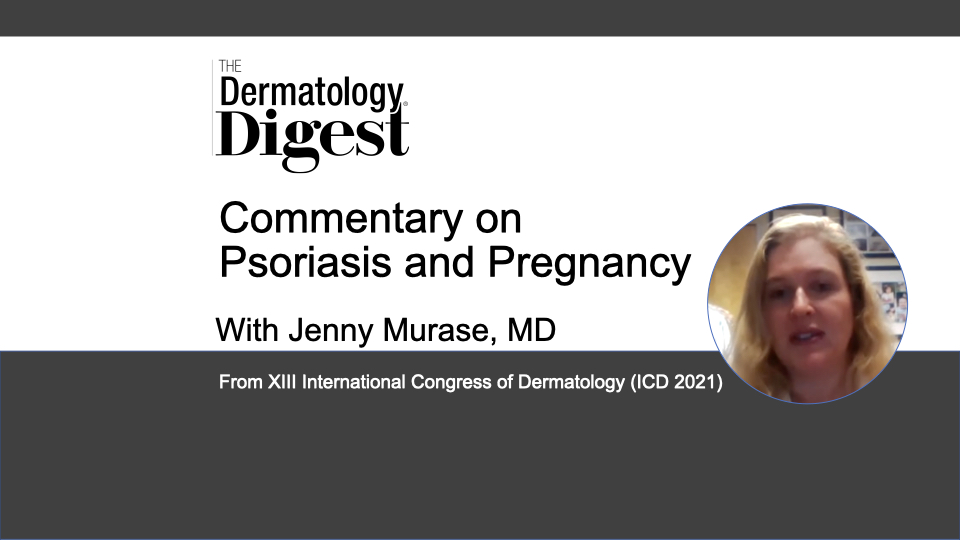Dr. Jenny Murase discusses treatment options and management for patients with psoriasis who are or may become pregnant.
Jenny Murase, MD, is Associate Clinical Professor of Dermatology at the University of California, San Francisco, and Director of Medical Consultative Dermatology, Palo Alto Medical Foundation, Mountain View, California.
“As we know, psoriasis is a chronic inflammatory skin disease, and so, whenever a patient is on therapy long term, you have to assume that they might become pregnant on a therapy you’ve prescribed them,” said Jenny Murase, MD, who presented “Psoriasis and Pregnancy” at XIII International Congress of Dermatology (ICD 2021).
“For patients who are pregnant, there are good options where they can be very comfortable throughout their pregnancy and have a safe delivery if they select therapies that are safe during pregnancy.”
The problem is, said Dr. Murase, patients on psoriasis therapies who are of childbearing age rarely seek out physician guidance before they become pregnant.
“It’s very common for people to become pregnant without having a discussion [with their physicians] and be on these chronic therapies, so really, the onus is on us as dermatologists to initiate the conversation and make sure that if a patient does become pregnant on the therapy, they know the impact of the therapy on a potential fetus.”
According to Dr. Murase, light therapy is very safe during pregnancy. However, studies show a reduction in folic acid levels over time for patients on long-term narrowband UVB phototherapy to treat psoriasis, she said.
“So it’s important to make sure that patients that are on light therapy in their childbearing years are on a prenatal vitamin, taking at least 1 mg folic acid a day.”
Of the available biologics, anti-TNF-alpha agents have the most safety data to support use during pregnancy, said Dr. Murase. In particular, certolizamab (Cimzia) has been studied extensively in pregnant and breastfeeding women because it is Fc-free, preventing antibody transference across the placenta.
“There are more supportive data for the TNF agents than IL-23 and IL-17 agents, so I personally feel more comfortable going with what agents have the most data. And I think certolizumab would be a very good choice because then you don’t have to worry about transitioning in second or third trimester.”
Other anti-TNF agents that do cross the placenta (eg, infliximab, adalimumab) can cause immunosuppression in the fetus, said Dr. Murase. In which case, “The first six to nine months of life live vaccines are not recommended.”
Although data are limited, etanercept is another TNF biologic that has a low transplacental rate, she said.
Notably, pregnancy itself can be therapeutic, said Dr. Murase.
“I initially became interested in saying this over 20 years ago because when I was starting medical school, the chair of the department brought in a patient who had very severe psoriasis. She was just covered from head to toe. He asked the patient about her pregnancies, and she said the only three times in her life that she was completely cleared was during her pregnancies.”
According to Dr. Murase, about 50% of patients experience an average of 80% resolution of skin lesions during pregnancy.
“It can be a very dramatic improvement and they may not need therapy during pregnancy, or you can reduce the frequency that you’re even administering therapy.”
However, postpartum, two-thirds of these patients will experience a return to baseline psoriasis. And that means having a plan to avoid Koebnerization of the nipples for those new mothers who intend to breastfeed, said Dr. Murase.
“If the nipples Koebnerize, that can be very painful. So in order to prevent that Koebnerization, you want the nipples [and] the skin to be in as good shape as possible prior to delivery.”
Dr. Murase also pointed out that the ABCDX classifications are no longer used to describe risk of using psoriasis therapies in pregnant or lactating women.
“That’s been changed within the past few years with the Pregnancy and Lactation Labeling Rule. So we don’t use those categories that dermatologists have used for a very long time… instead, it’s narrative-based, where you’re actually giving specific risks for medicine.”


